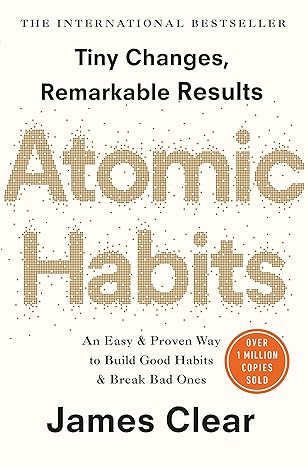Introduction
“Atomic Habits: Tiny Changes, Remarkable Results” by James Clear is a transformative guide that illustrates the power of small, incremental changes in our daily habits to achieve remarkable results over time. Clear’s book emphasizes the compound effects of habits that are as tiny and powerful as atoms, offering actionable strategies to reshape your habits, thereby reshaping your life. This summary distills the core principles and actionable steps from Clear’s work into a concise, five-minute read.
The Fundamentals of Atomic Habits
Understanding the Impact of Small Changes
- The Compound Effect: Just as atoms are the building blocks of molecules, atomic habits are the fundamental units of our routines, with small changes leading to significant impacts over time.
- The 1% Rule: Improving by just 1% every day can lead to massive growth and improvement by the end of the year, illustrating the power of compounding.
- Habit Stacking: Building new habits onto existing ones (habit stacking) can anchor our routines in already established behaviors, making them easier to adopt.
The Four Laws of Behavior Change
- Make It Obvious: Design your environment to highlight the cues of good habits and hide the cues of bad ones.
- Make It Attractive: Bundle the habits you need to do with the habits you want to do to make them more appealing.
- Make It Easy: Reduce the friction associated with good habits. Simplify the steps to make actions easy to repeat.
- Make It Satisfying: Use reinforcements and rewards to make good habits feel immediately satisfying, ensuring they stick.
Strategies for Building Better Habits
Creating a Positive Environment
- Environment Design: Adjust your surroundings to make the cues of desired habits obvious and the cues of harmful habits invisible.
- Motivation vs. System: Focus on building systems that make the execution of good habits inevitable, rather than relying solely on motivation.
- Feedback Loops: Establish immediate feedback for your habits, ensuring that positive behaviors are reinforced quickly.
Overcoming Challenges to Habit Formation
- The Two-Minute Rule: When starting a new habit, scale it down to two minutes or less to make the starting threshold as low as possible.
- Habit Tracking: Keep a visual tracker of your habit streaks to provide clear evidence of your progress and to motivate continuous adherence.
- Dealing with Plateaus: Recognize that plateaus are a natural part of the process. Use them as opportunities to reassess and adjust your strategies.
Actionable Steps to Implement Atomic Habits
- Identify Your Habits: Start by making a list of your daily habits. Label each habit as effective, ineffective, or neutral towards your goals.
- Apply the Four Laws: For each effective habit, apply the four laws to make it obvious, attractive, easy, and satisfying. For each ineffective habit, invert these laws to make the habit unappealing and difficult.
- Habit Stacking Formula: After [CURRENT HABIT], I will [NEW HABIT]. Use this formula to stack new habits onto existing ones, linking new behaviors to established routines.
- Environment Design: Rearrange your environment to make cues of good habits prominent and remove cues of bad habits. If you want to read more, place a book on your pillow each morning.
- Use Reinforcements: Immediately reward yourself after completing a good habit to make it satisfying. Rewards should be aligned with your identity and goals.
- Track Your Progress: Create a habit tracker, whether digital or on paper, and make a mark for each day you complete your habit. This visual proof of your commitment can be highly motivating.
- Adjust as You Go: Regularly review your habits and their outcomes. If a habit is not bringing you closer to your goal, tweak the approach or replace it with a more effective one.
Conclusion
James Clear’s “Atomic Habits” provides a powerful framework for understanding and improving our daily habits. By focusing on tiny changes, we can make substantial improvements in our lives. The strategies outlined in this book are both practical and actionable, making habit formation accessible to everyone. By implementing these steps, you can start on the path to positive change, one small habit at a time.

